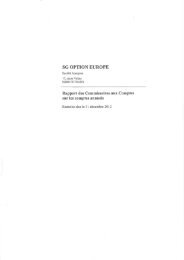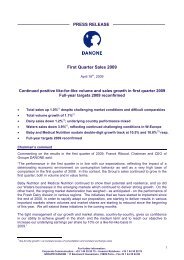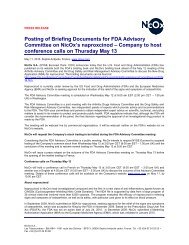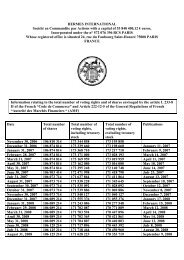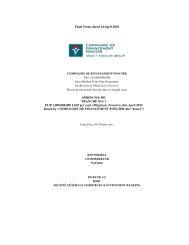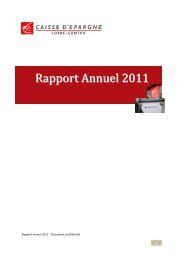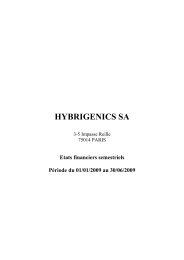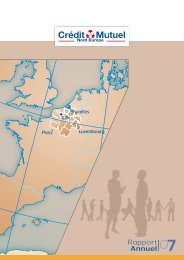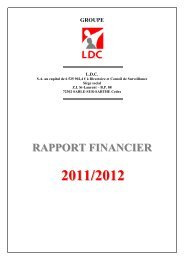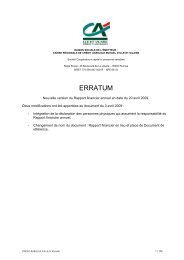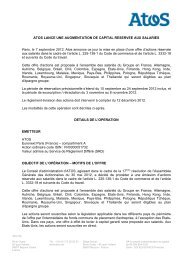Financial Reporting - Rexel
Financial Reporting - Rexel
Financial Reporting - Rexel
Create successful ePaper yourself
Turn your PDF publications into a flip-book with our unique Google optimized e-Paper software.
to each period during the lease term so as to produce a constant periodic rate of interest on the remaining<br />
balance of the liability. The capital gains arising from the sale and leaseback of property, plant and<br />
equipment are recognized in full upon sale when the lease qualifies as an operating lease and the<br />
transaction is realized at fair value. They are spread on a straight-line basis over the lease term in case of a<br />
finance lease.<br />
Assets held under finance leases are depreciated over their expected useful lives on the same basis as<br />
owned assets or, when shorter, the term of the finance lease.<br />
Payments made under operating leases are recognized in the income statement on a straight-line basis over<br />
the term of the lease. Lease incentives received are recognized in the income statement on a straight-line<br />
basis as an integral part of the total lease expense.<br />
Depreciation<br />
Depreciation is charged to profit or loss on a straight-line basis over the estimated useful lives of each part of<br />
an item of property, plant and equipment.<br />
Land is not depreciated.<br />
The estimated useful lives are as follows:<br />
• Commercial and office buildings 20 to 35 years<br />
• Building improvements and operating equipment 5 to 10 years<br />
• Transportation equipment 3 to 8 years<br />
• Computers and hardware 3 to 5 years<br />
The assets’ residual values, useful lives, and methods of depreciation are reviewed and adjusted if<br />
appropriate at each balance sheet date.<br />
2.7 | Investments in Associates<br />
Investments in entities over which the Group has a significant influence are accounted for using the equity<br />
method.<br />
Interests in associates are initially carried at cost which includes transaction costs.<br />
The consolidated financial statements include the Group’s share in the results of operations and other<br />
components of the comprehensive income, after taking into account adjustments for homogenization with the<br />
Group’s accounting policies.<br />
When the Group’s share in the losses is greater than the value of their interest in the associate, the carrying<br />
amount is reduced to zero and the Group ceases to account for its share in future losses, unless the Group<br />
has an obligation to share in the losses.<br />
2.8 | Impairment<br />
The carrying amounts of the Group’s assets, other than inventories (see note 2.9), trade, and other accounts<br />
receivable (see note 2.10.3), and deferred tax assets (see note 2.20), are reviewed at each balance sheet<br />
date to determine whether there is any indication of impairment. If any such indication exists, the asset’s<br />
recoverable amount is estimated (see below).<br />
The recoverable amount of intangible assets that have an indefinite useful life and of intangible assets that<br />
are not yet available for use is estimated annually or as soon as there is an indication of impairment.<br />
Goodwill is not amortized but subject to an impairment test, as soon as there is an indication that it may be<br />
impaired, and at least once a year. Indications that goodwill may be impaired include material adverse<br />
changes of a lasting nature affecting the economic environment or the assumptions and objectives made at<br />
the time of acquisition.<br />
An impairment loss is recognized whenever the carrying amount of an asset or of its cash-generating unit<br />
exceeds its recoverable amount. Impairment losses are recognized in the income statement (in “Other<br />
expenses”).<br />
32



